warning light Oldsmobile Cutlass 1998 s User Guide
[x] Cancel search | Manufacturer: OLDSMOBILE, Model Year: 1998, Model line: Cutlass, Model: Oldsmobile Cutlass 1998Pages: 348, PDF Size: 17.46 MB
Page 121 of 348
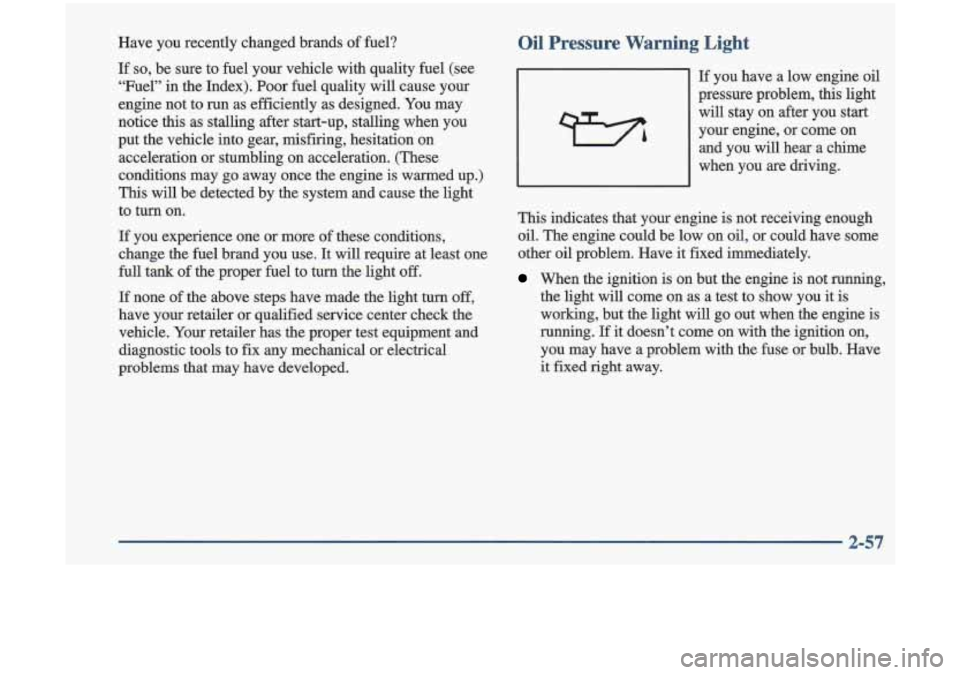
Have you recently changed brands of fuel?
If so, be sure to fuel your vehicle with quality fuel (see
“Fuel” in the Index).
Poor fuel quality will cause your
engine not to
run as efficiently as designed. You may
notice this as stalling after start-up, stalling when you
put the vehicle into gear, misfiring, hesitation on
acceleration or stumbling on acceleration. (These
conditions may
go away once the engine is warmed up.)
This will be detected by the system and cause the light
to
turn on.
If you experience one or more of these conditions,
change the fuel brand you use. It will require at least one
full tank of the proper fuel to
turn the light off.
If none of the above steps have made the light turn off,
have your retailer or qualified service center check the
vehicle. Your retailer has the proper test equipment and
diagnostic tools to fix any mechanical or electrical
problems that may have developed.
Oil Pressure Warning Light
If you have a low engine oil
pressure problem, this light
will stay on after you start
your engine,
or come on
and you will
hear a chime
when you are driving.
This indicates that your engine is not receiving enough
oil. The engine could be low
on oil, or could have some
other oil problem. Have it fixed immediately.
When the ignition is on but the engine is not running,
the light will come on as a test to
show you it is
working, but the light will
go out when the en-gine is
running. If it doesn’t come on with the ignition on,
you may have a problem with the fuse or bulb. Have
it fixed right away.
2-57
Page 123 of 348
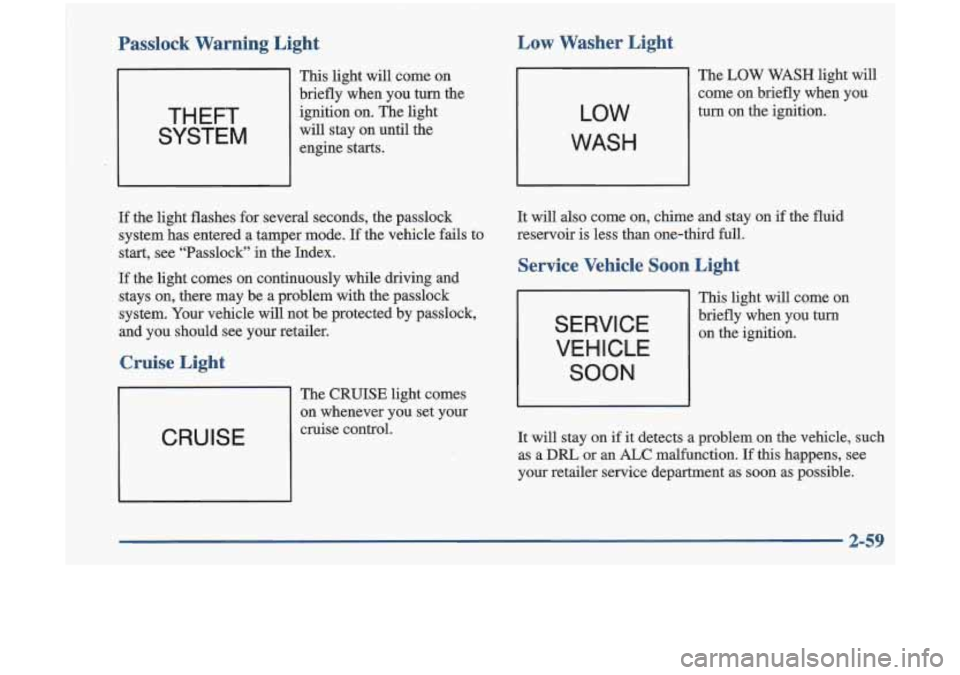
Passlock Warning Light Low Washer Light
This light
will come on
briefly when you
turn the
ignition on. The light
will stay on until the
engine starts.
If the light flashes for several seconds, the passlock
system has entered a tamper mode.
If the vehicle fails to
start, see “Passlock” in the Index.
If the light comes on continuously while driving and
stays on, there may be a problem with the passlock
system. Your vehicle will not be protected by passlock,
and you should see your retailer.
Cruise Light
CRUISE
The CRUISE light comes
on whenever you set your
cruise control.
LOW
WASH
The LOW WASH light will
come on briefly when you
turn on the ignition.
It will also come on, chime and stay on if the fluid
reservoir is less than one-third full.
Service Vehicle Soon Light
SERVICE
VEHICLE
SOON
This light will come on
briefly when you turn
on the ignition.
It will stay on
if it detects a problem on the vehicle, such
as a
DRL or an ALC malfunction. If this happens, see
your retailer service department as soon as possible.
2-59
Page 153 of 348
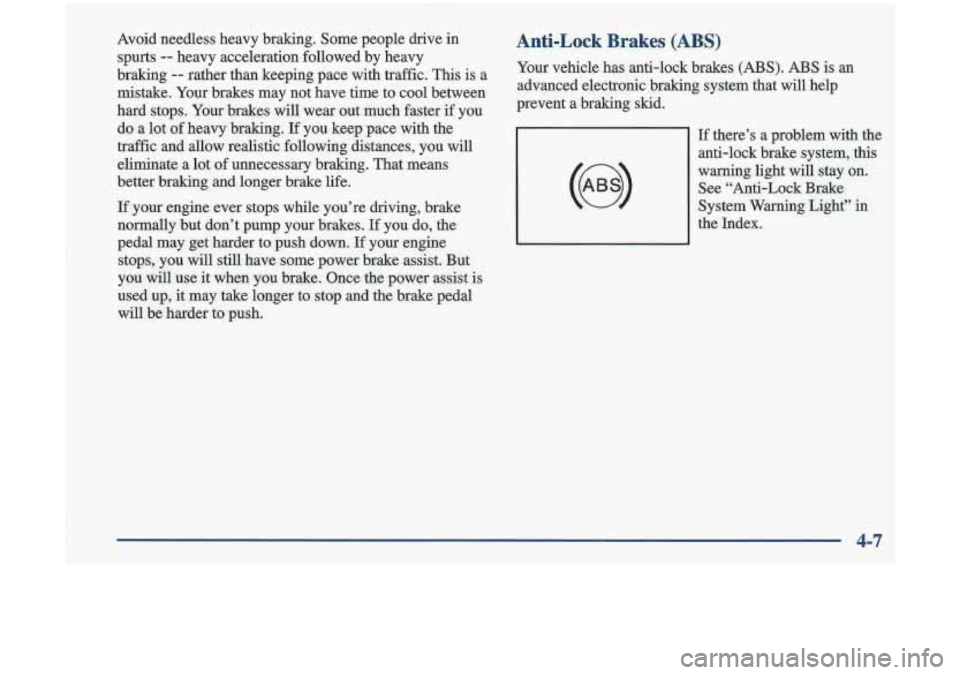
Avoid needless heavy braking. Some people drive in
spurts -- heavy acceleration followed by heavy
braking
-- rather than keeping pace with traffic. This is a
mistake. Your brakes may not have time to cool between
hard stops. Your brakes will wear out much faster
if you
do a lot
of heavy braking. If you keep pace with the
traffic and
allow realistic following distances, you will
eliminate a lot of unnecessary braking. That means
better braking and longer brake life.
If your engine ever stops while you’re driving, brake
normally but don’t pump your brakes.
If you do, the
pedal may get harder to push down. If your engine
stops, you
will still have some power brake assist. But
you
will use it when you brake. Once the power assist is
used up, it may take longer to stop and the brake pedal
will be harder to push.
Anti-Lock Brakes (ABS)
Your vehicle has anti-lock brakes (ABS). ABS is an
advanced electronic braking system that will help
prevent a braking skid.
If there’s a problem with the
anti-lock brake system,
this
warning light will stay on.
See “Anti-Lock Brake
System Warning Light”
in
the Index.
4-7
Page 170 of 348
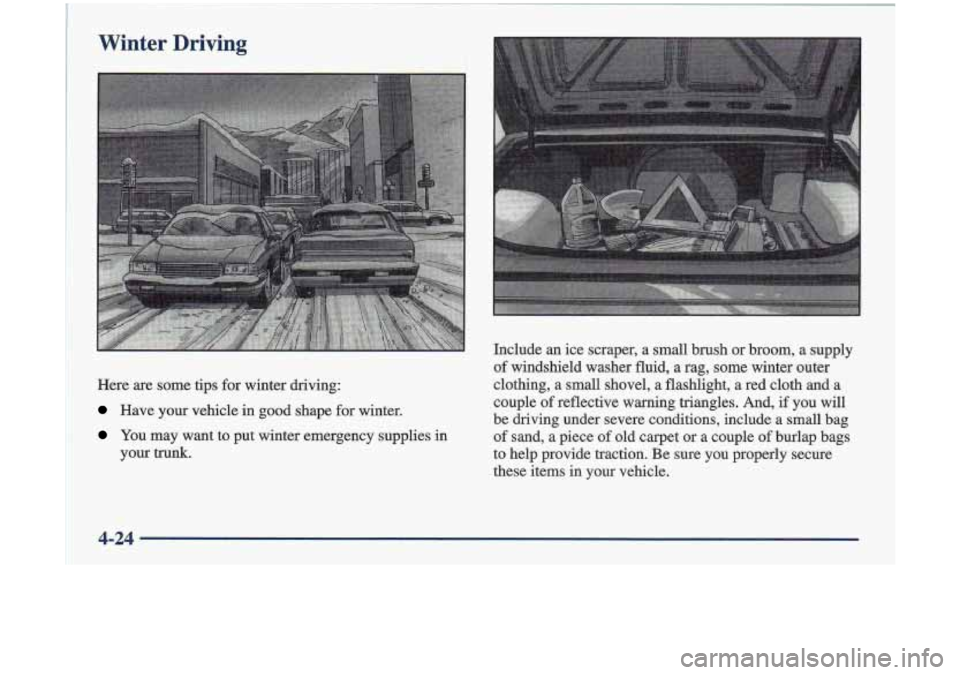
Winter Driving
Here are some tips for winter driving:
Have your vehicle in good shape for winter.
You may want to put winter emergency supplies in
your
mnk.
Include an ice scraper, a small brush or broom, a supply
of windshield washer fluid, a rag, some winter outer
clothing, a small shovel, a flashlight, a red cloth
and a
couple
of reflective warning triangles. And, if you will
be driving under severe conditions, include a small bag
of sand, a piece of old carpet or a couple of burlap bags
to help provide traction. Be sure you properly secure
these items in your vehicle.
4-24
Page 198 of 348
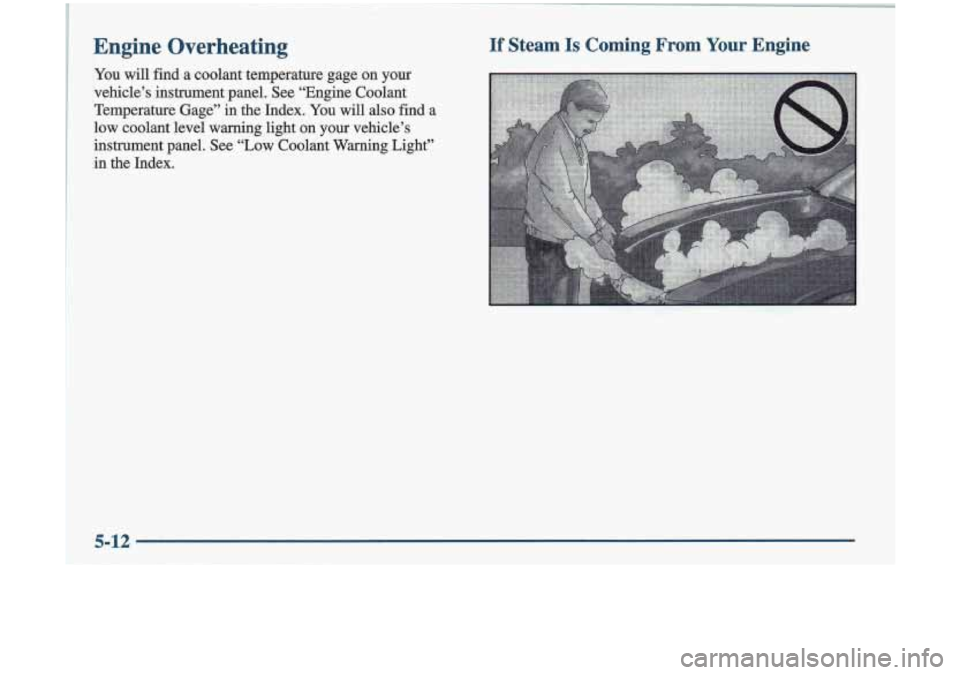
Engine Overheating
You will find a coolant temperab Ire gage on
vehicle’s instrument panel. see “Engine Coo
If Steam Is Coming From Your Engine
your
dant
Temperature Gage”
in the Index. You will also find a
low coolant level waming light on your vehicle’s
instrument panel. See
“LOW Coolant Warning Light”
in the Index.
5-12
Page 238 of 348
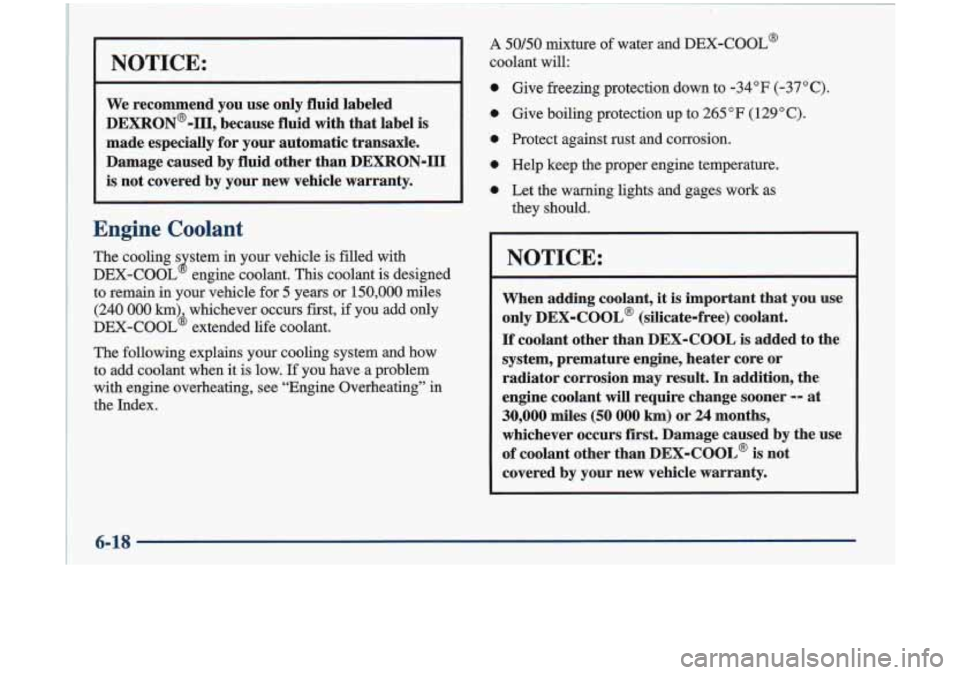
1 I
NOTICE:
We recommend you use only fluid labeled
DEXRON@-III, because fluid with that label is
made especially for your automatic transaxle.
Damage caused by fluid other than DEXRON-I11
is not covered by your new vehicle warranty.
Engine Coolant
The cooling s stem in your vehicle is filled with
DEX-COOL engine coolant. This coolant is designed
to remain in your vehicle for
5 years or 150,000 miles
(240 000 km) whichever occurs first, if you add only
DEX-COOL’ extended life coolant.
J
The following explains your cooling system and how
to add coolant when it is low. If you have a problem
with engine overheating,
see “Engine Overheating” in
the Index.
A 50/50 mixture of water and DEX-COOL@
coolant will:
0 Give freezing protection down to -34°F (-37°C).
0 Give boiling protection up to 265 OF (1 29 O C).
0 Protect against rust and corrosion.
0 Help keep the proper engine temperature.
0 Let the warning lights and gages work as
they should.
NOTICE:
When adding coolant, it is important that you use
only
DEX-COOL@ (silicate-free) coolant.
If coolant other than DEX-COOL is added to the
system, premature engine, heater core or
radiator corrosion may result. In addition, the
engine coolant will require change sooner
-- at
30,000 miles (50 000 km) or 24 months,
whichever occurs first. Damage caused by the use
of coolant other than DEX-COOL@
is not
covered by your new vehicle warranty.
6-18
Page 245 of 348
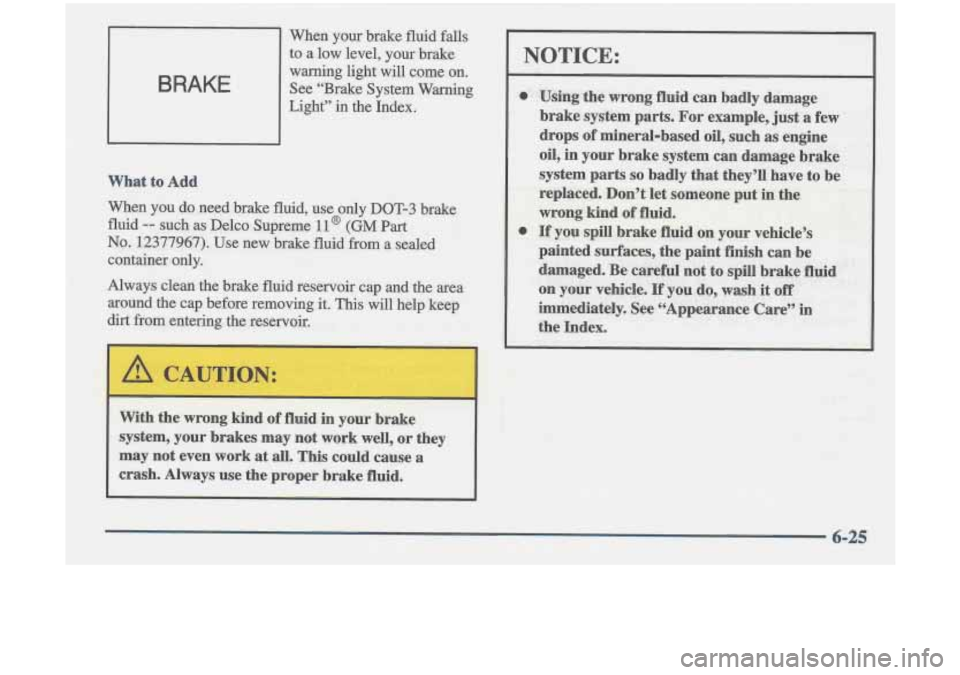
BRAKE
When your bmke fluid fa
to a low level, your brake
warning light will come on.
See ‘‘Brake System Wm
Light’9 in the hdex.
NOTICE:
0
0
Page 246 of 348
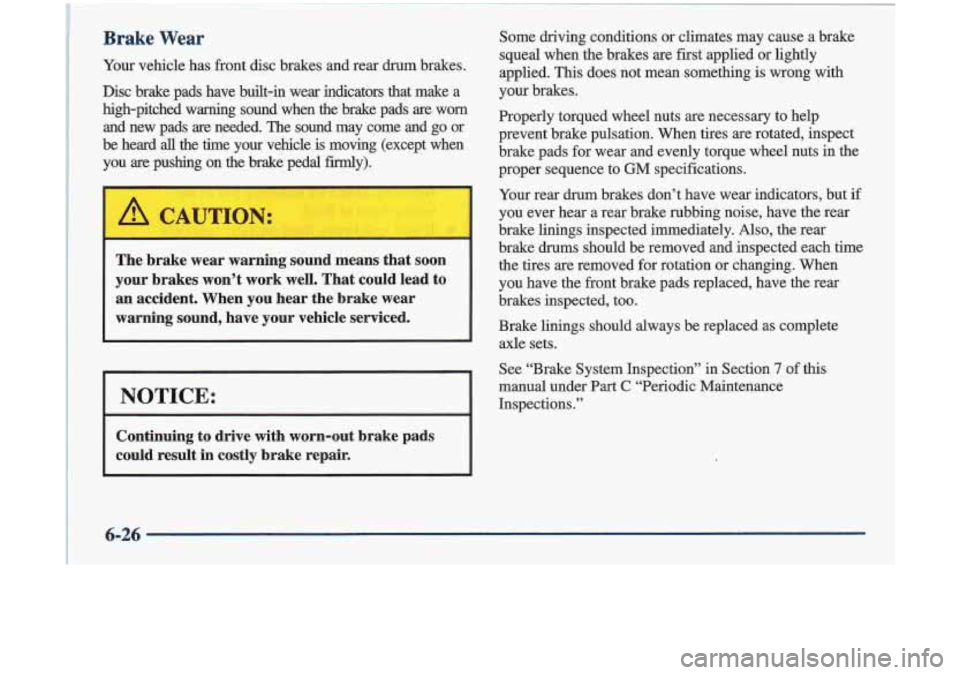
Brake Wear
Your vehicle has front disc brakes and rear drum brakes.
Disc brake pads have built-in wear indicators that make a
high-pitched warning sound when the brake pads are
worn
and new pads are needed. The sound may come and go or
be heard
all the time your vehicle is moving (except when
you
are pushing on the brake pedal firmly).
The brake wear warning sound means that soon
your brakes won’t work well. That could lead
to
an accident. When you hear the brake wear
warning sound, have your vehicle serviced.
I NOTICE:
~~ ~ ~~
Continuing to drive with worn-out brake pads
could result
in costly brake repair.
Some driving conditions or climates may cause a brake
squeal when the brakes are first applied or lightly
applied. This does not mean something is wrong with
your brakes.
Properly torqued wheel nuts are necessary to help
prevent brake pulsation. When tires are rotated, inspect
brake pads for wear and evenly torque wheel nuts in the
proper sequence to GM specifications.
Your rear drum brakes don’t have wear indicators, but
if
you ever hear a rear brake rubbing noise, have the rear
brake linings inspected immediately. Also, the rear
brake drums should be removed and inspected each time the tires are removed for rotation or changing. When
you have the front brake pads replaced, have the rear
brakes inspected, too.
Brake linings should always be replaced as complete axle sets.
See “Brake System Inspection” in Section
7 of this
manual under Part
C “Periodic Maintenance
Inspections.”
6-26
Page 259 of 348
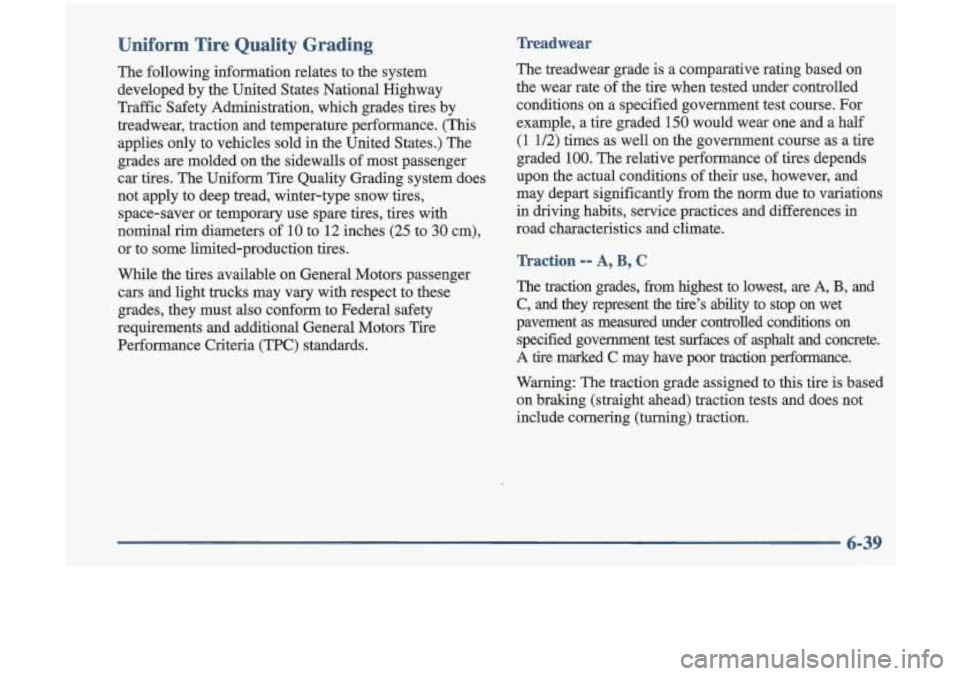
Uniform Tire Quality Grading
The following information relates to the system
developed by the United States National Highway
Traffic Safety Administration, which grades tires by
treadwear, traction and temperature performance.
(This
applies only to vehicles sold in the United States.) The
grades are molded on the sidewalls of most passenger
car tires. The Uniform Tire Quality Grading system does
not apply to deep tread, winter-type snow tires,
space-saver or temporary use spare tires, tires with
nominal rim diameters of
10 to 12 inches (25 to 30 cm),
or to some limited-production tires.
While the tires available on General Motors passenger cars and light trucks may vary with respect to these
grades, they must also conform to Federal safety
requirements and additional General Motors Tire
Pedomance Criteria (PC) standards.
Treadwear
The treadwear grade is a comparative rating based on
the wear rate of the tire when tested under controlled
conditions on a specified government test course. For
example, a tire graded 150 would wear one and a half
I I
(1 1/2) times as well on the government course as a tire ~
graded 100. The relative performance of tires depends 1
upon the actual conditions of their use, however, and
may depart significantly from the nom due to variations
in driving habits, service practices and differences in
road characteristics and climate. ! i
1
Traction -- A, B, C
The traction grades, fkom highest to lowest, are A, B, and
C, and they represent the tire’s ability to stop on wet
pavement
as measured mder controlled conditions on
specified government test surfaces of asphalt and concrete.
A tire marked C may have poor traction perfomce.
Warning: The traction grade assigned to this tire is based
on braking (straight ahead) traction tests and does not
include cornering (turning) traction.
Page 331 of 348
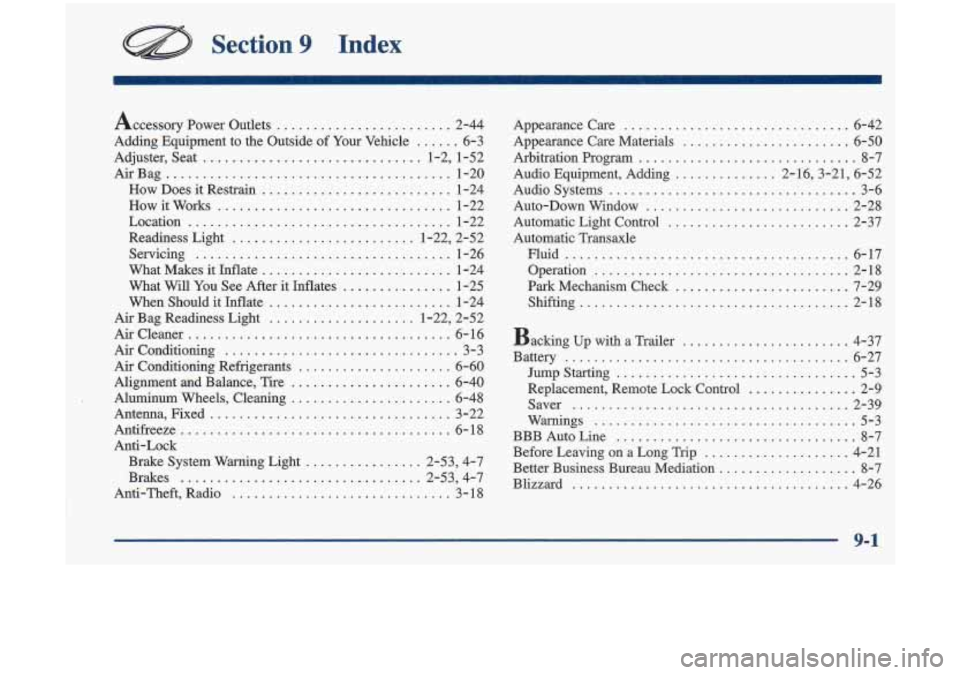
Section 9 Index
Accessory Power outlets ........................ 2-44
Adding Equipment to the Outside
of Your Vehicle ...... 6-3
Adjuster. Seat
.............................. 1.2. 1.52
AirBag
....................................... 1-20
How Does it Restrain .......................... 1-24
How it Works
................................ 1-22
Location
.................................... 1-22
Readiness Light
......................... 1.22. 2.52
Servicing
................................... 1-26
What Makes it Inflate
.......................... 1-24
What Will You See After it Inflates
............... 1-25
When Should it Inflate
......................... 1-24
Air Bag Readiness Light .................... 1.22. 2.52
Aircleaner
.................................... 6-16
Air Conditioning
................................. 3-3
Air Conditioning Refrigerants ..................... 6-60
Alignment and Balance. Tire
...................... 6-40
Aluminum Wheels. Cleaning
...................... 6-48
Antenna. Fixed
................................. 3-22
Antifreeze
..................................... 6-18
hti-Lock Brake System Warning Light
................ 2.53. 4.7
Brakes
................................. 2.53. 4.7
Anti.Theft. Radio
.............................. 3-18 Appearance Care
............................... 6-42
Appearance Care Materials
....................... 6-50
ArbitrationProg
ram .............................. 8-7
Audio Equipment, Adding
.............. 2-16,3-21, 6-52
Audio Systems
.................................. 3-6
Auto-Down Window
............................ 2-28
Automatic Light Control
......................... 2-37
Automatic Transaxle Fluid
....................................... 6-17
Operation
................................... 2-18
Park Mechanism Check ........................ 7-29
Shifting
..................................... 2-18
Backing up with
a Trailer ....................... 4-37
Battery
....................................... 6-27
Jump Starting
................................. 5-3
Replacement. Remote Lock Control
............... 2-9
Saver
...................................... 2-39
BBB Auto Line
................................. 8-7
Before Leaving on a Long Trip
.................... 4-21
Better Business Bureau Mediation
................... 8-7
Warnings .................................... 5-3
Blizzard ...................................... 4-26
9-1